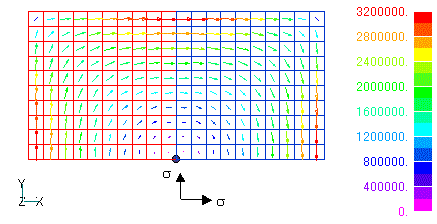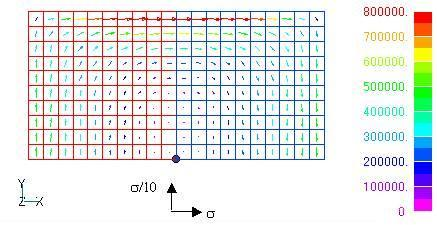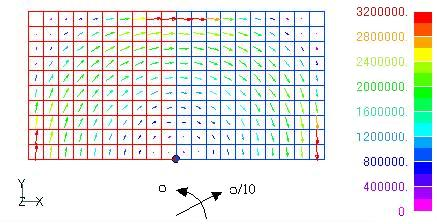Analysis of Anisotropic Nonmagnetic Thin Plates
- TOP >
- Analysis Examples by Functions (List) >
- Analysis of Anisotropic Nonmagnetic Thin Plates
Summary
EMSolution has been able to handle anisotropy in volume element conductors, but not in non-magnetic conductor plates with face elements. Starting with r8.6, it is now possible. An example is shown below.
Explanation
The analytical model is the same as that used in Fig. 1 in "Analysis of a Nonmagnetic Thin Plate by Surface Elements". Models with volume elements and face elements are calculated simultaneously.
Fig. 1 below shows the current density distribution for the isotropic conductivity case used in "Analysis of a Nonmagnetic Thin Plate by Surface Elements". The right half is modeled with volume elements and the left half with face elements. Almost the same distribution is obtained for the left and right halves.
Fig. 2 shows the case where anisotropy of 1/10 conductivity in the y-direction is included. Anisotropy is added to both volume and face elements. In this case, the overall eddy currents are smaller, and the y-directional current concentration is smaller. The left and right sides have nearly the same distribution, indicating that the volume and surface elements exhibit similar anisotropy.
Fig. 3 shows the case where the conductivity in the r direction is 1/10 in a cylindrical coordinate system centered at the origin. The current flows in the circumferential direction. Also in this case, the distribution is the same on both sides, indicating that the approximation by the volume element is equivalent to that by the face element. Table 1. shows the total Joule heating on both sides for each case. In all cases, the two values are in good agreement, indicating that similar anisotropy is given for the volume and surface elements.
Table 1. Total Joule heating on both sides for each case
| case | Total heat generation in the volume element region (W) | Total heat generation in the face element region (W) |
|---|---|---|
| For uniform electrical conductivity | 3.5196 | 3.4613 |
| Conductivity in y direction is 1/10 | 0.66916 | 0.66625 |
| Conductivity in the r direction is reduced to 1/10 | 3.0483 | 2.9252 |
The rest of this page is for members only.
Analysis Examples by Functions
Non-magnetic thin plate face elements
- Nodal and Lorentz forces in nonmagnetic materials
- Analysis of Rectangular Spiral Inductors
- Cutting of thin Conductor surfaces with gap elements (Part 2)
- Cutting of thin conductor surfaces with gap elements (Part 1)
- Analysis of Anisotropic Nonmagnetic Thin Plates
- Analysis of Nonmagnetic Thin Plates with Surface Elements
- Lorentz force acting on non-magnetic thin plate elements
©2020 Science Solutions International Laboratory, Inc.
All Rights reserved.





